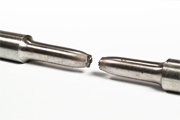 RA% is a term that stands for “reduction of area percentage.” It is an important requirement of the ASTM F1554 specification, in addition to other specifications. This value is reported as a percentage of the original test piece. When fasteners undergo mechanical testing, they are pulled to failure and the diameter of the point at which the fastener breaks is measured and compared to the original diameter. The difference between the original sample and the broken piece is calculated and reported as the reduction of area percentage.
RA% is a term that stands for “reduction of area percentage.” It is an important requirement of the ASTM F1554 specification, in addition to other specifications. This value is reported as a percentage of the original test piece. When fasteners undergo mechanical testing, they are pulled to failure and the diameter of the point at which the fastener breaks is measured and compared to the original diameter. The difference between the original sample and the broken piece is calculated and reported as the reduction of area percentage.
Each grade of ASTM F1554 has a minimum requirement to meet. For example, grade 36 has a 40% minimum reduction of area requirement which means that in order for the bolt to comply to this specification it must reduce in diameter at least 40% (or more) before breaking.
23mm to 21.60mm how many reduction %
please send formula.
@Devendrasinh- If you calculate the area of both sections (Pi x r^2), and subtract the smaller from the larger, then divide the difference by the larger, you are left with an 11.8% reduction of area. I hope that helps.
Can you comment on the substitutability of A193 B7 in lieu of A354 BC for 150psig sat steam application.
@Stew- A193B7 and A354BC are very similar, but do have a few differences. A193 is a high temperature specification and is heat treated to withstand higher temperatures. A354 is slightly stronger, (109ksi yield vs 105ksi yield) and is mostly used for general purpose applications. If you are wanting to make a substitution, we would recommend running it past the project engineer to be safe, but these two grades are quite similar.
hello sir
please tell me that if elongation is less than the require standard then what we will do?
1) reject all bolts
2) re sampling or
it is acceptable to use
for example GR 36 elongation is coming 9%..
and what is the sampling method for same heat no but different size and how much should test
@Mazhar- It sounds as if the elongation is severely below the minimum, and I would think that is grounds for rejection. Neither F1554 nor F1470 (sampling plan) allows for re-sampling, so that would be at the discretion of the project engineer.
Is it unusual for the requirement for RA% to increase as the tensile strength increases?
For instance for 1 3/4″ material
F1554 Gr55 AR% is 30%, elongation is 21%
F1554 Gr105 AR% is 45%, elongation is 15%
@Jeff- Not necessarily, however in this case you are comparing apples and oranges. Grade 55 material is low carbon, low alloy as-rolled steel, whereas Grade 105 is a heat treated alloy steel. So yes the RA% is higher on the grade 105, but it is high alloy and thermally treated, so it reacts much differently than the grade 55. A further example is ASTM A354 grade BD. It is made from the same alloy steel as grade 105, but it is heat treated to a higher tensile. The minimum RA% of that grade is 40. Typically, as tensile increases, ductility decreases, all thing being equal.
What is the effect of RA% = “Reduction of Area” of anchor bolt to the structure (e.g. Pipe Rack Pedestals, Equipment Foundations, etc.)? What will happen if RA% less than the requirements?
@Wilson – Reduction of Area is, along with Elongation, a measure of ductility. From an engineering and seismic standpoint, it is ideal for the anchor bolts, when overloaded, to stretch rather than shatter. A minor variance from the minimum requirements may not be detrimental, but a large variation might be. Determining how detrimental, and determining at what point problems occur is likely specific to the application and is something that an engineer familiar with the job should be consulted on.